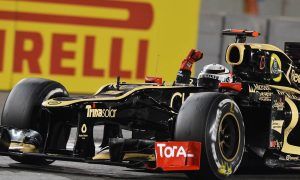RENAULT – STICKING TO A CONVENTIONAL DESIGN
Returning as a constructor in 2016, Renault plans on keeping its fairly conventional power unit architecture this year, i.e. the compressor is placed side-by-side with the turbine, The French manufacturer’s layout presents both advantages and inconveniences, but it will now be assessed in the light of how well the engine performs within Renault's own chassis.
New chief technical officer Bob Bell will ensure smooth cooperation between the power unit department in Viry-Châtillon and the chassis division in Enstone, using the same method he utilised at Mercedes between 2011 and late 2013. Cyril Abiteboul has already warned that originality should not be sought at any cost.
“We don’t want headaches, issues, so we have asked Enstone to be conservative in their solutions, their approach, and it will be the same in Viry on the engine side,” said the Renault Sport Racing managing director.
“We think we know what we have to do, but we are not going to try and rush the introduction of things that will not be ready. We need to be extremely careful about that.”
Redesigning the turbocharger, if needs be, does not require a major overhaul since the component is outside the V6.
FERRARI – GOING BACK TO ITS ROOTS
Ferrari’s power unit is an interesting case study. The Italian engine initially featured a downsized turbocharger in order to declutter the rear of the 2014-spec F14T. The rationale was that better aero efficiency would offset the loss in power. The problem is that it never actually happened.
Indeed, a smaller turbine generates less power and more back pressure, which ends up penalising the internal combustion engine (ICE) in the higher RPMs (since wastegates are quite often open). In a way, Ferrari sacrificed core engine efficiency to streamline the car's aerodynamics.
When time came to design their new-for-2015 power unit, Maranello engineers reconsidered the respective importance of engine and aero and decided to increase the turbine sizing and revert to more traditional exhaust tubes.
Having a bigger turbine on the 059/4 means the MGU-H absorbs more power from the turbine shaft, which in turn leads to greater electric deployment. In just one season, Ferrari corrected the situation by forfeiting the extremely compact architecture it had originally gone for.
For its 2016 engine, the Scuderia is believed to have embraced traditional and field-proven setups even more. According to Giorgio Piola, Ferrari has been able to install variable inlet trumpets after removing its large intercooler from inside the ‘Vee’ and replacing it by two smaller elements. One sits above the oil tank, just like on the championship-winning Mercedes W05 and W06, while the other is on the right hand side of the engine.
The MGU-K has also been repositioned to feature on the left hand side. This has been done with an eye towards trimming down the back of the car. Finally, the clutch sits on the internal combustion engine (ICE) instead of being gearbox-mounted, as it is on the Mercedes and Honda engines.








